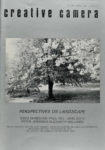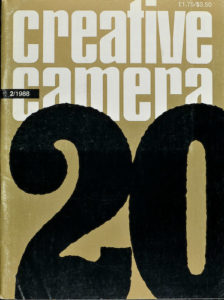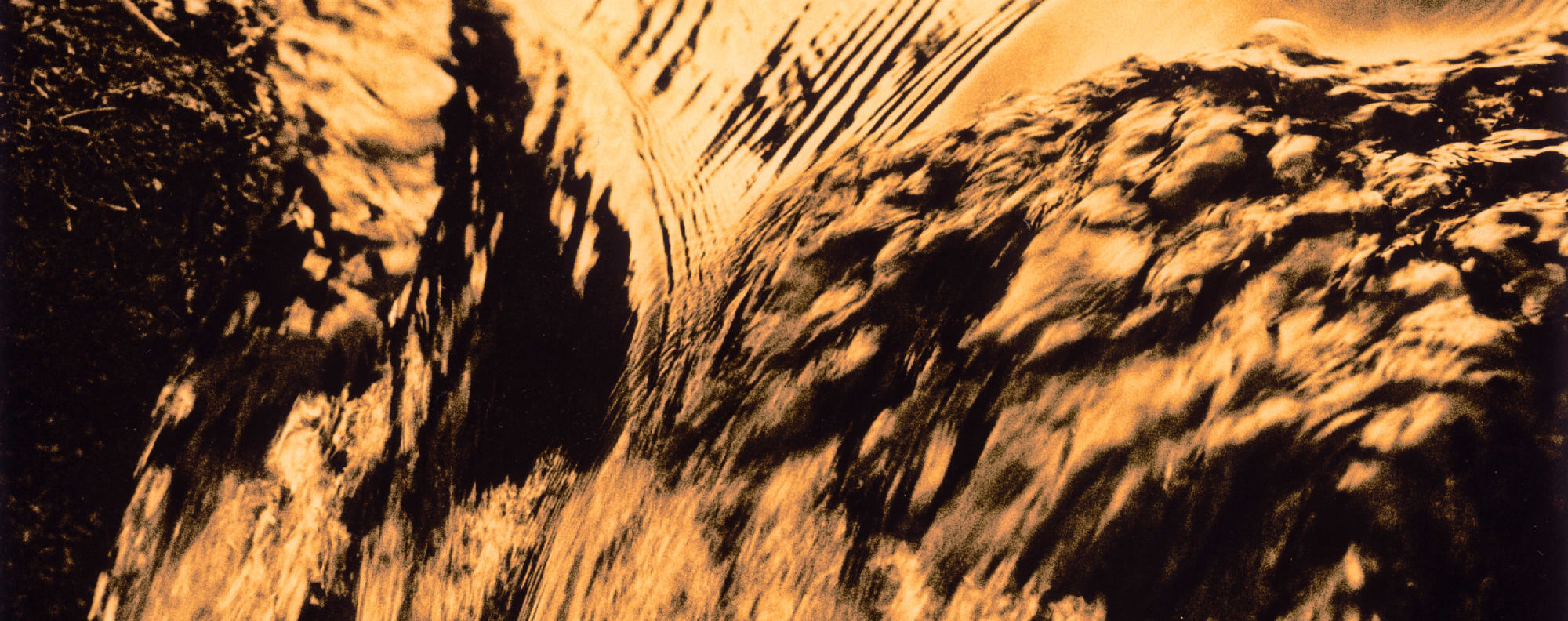
The idea of Creative Camera without Colin Osman as Editor and Publisher seems slightly absurd. The magazine he helped found to promote the worth of photography as a medium of personal expression has passed through a number of evolutionary phases, undergone several metamorphoses, even done the occasional chameleon act. But it has always been watched over, guided and gently prodded by the same, generally benign father figure. We haven’t had many such figures in British photography, in fact I cannot think of any except Norman Hall and he belonged to an earlier generation. Good reason, then, that Colin’s absence from the helm should strike that absurd note. He was, indeed remains, quite unique.
When Peter Turner left Creative Camera, for the second and last time, in June 1991, he wrote this text in Issue 310:“When I first parted company with CC in 1978, I recall producing an editorial defending my position in the face of reader comments which accused the magazine of increasing ‘senselessness’.
I finished by asking the magazine to continue in its founding spirit and be ‘unreasonable’, that is to simultaneously celebrate the present, examine the past and suggest the future. All all within the context of a cultural sweep. Photography, poetry, painting, architecture, cinema, literature. We picture what we know or what we want to discover.More than a decade later it strikes me as ironic to be saying the same thing. But I must. When I returned six years ago I was conscious that an influential group hoped I could recreate their golden era. I couldn’t, of course. They wanted a particular form, I offered an idea of values. Magazines should be of their moment. From ’60s innocence, hope and achievement in the ’70s, the rifts and fractures of the ’80s; it has been CCs role to be a chameleon and reflect change not a fixed idea. My reward has been to see the magazine through a tough time. Financially and in terms of CC’s identity, the pressures have been extreme. I believe, if you can forgive my conceit, I am leaving a better magazine than the one I inherited. And my hope is for continued unreasonable behaviour. It is only through such a game plan that photography’s place within culture will ever be properly established.As a parting note, none of my conceit would have been possible without the support of my family. Which is photography. And my friends. You have kept me in beer, adrenalin, hope and occasional madness. Thank you. And ‘yes’, I would do it all again.”Peter Turner, 1991.
I met Colin Osman first in 1969. A year or so out of college, I had been an irregular visitor to 19 Doughty Street to take the tea and sympathy Bill Jay (then Editor) was famous for offering young photographers. The magazine seemed a life-line, a means of holding on to one’s sanity in a world where photographers were second-class citizens (unless they shot fashion pictures). At Creative Camera was a different matter and we came like bees to honey. Colin Osman was always a slightly shadowy figure — a name but no face, and it was not until the autumn of that year I actually met him. Bill told me he was leaving the magazine: he and Colin couldn’t agree on the financial future ‘there might be a job going for you’ he said. So I contacted the mysterious Mr Osman, went to see him and to my surprise was hired on the spot. Now, 16 years later, I am even more surprised. I was very ignorant – not about producing magazines but about photography. Perhaps in the context of 1969 it wasn’t so surprising as Creative Camera was alone in demanding some serious recognition for the medium. There were no galleries, no grants, virtually no books and no support. (One of Colin’s treasures is a mid-sixties letter from the Arts Council informing him, tersely, that as photography is not art it will not receive their support). Virgin territory to be opened up and explored. Which is what we did, exchanging ignorance for enthusiasm.
I should qualify that. My lack of knowledge was certain but Colin Osman had a few tricks up his sleeve. He had been passionate about photography well before he acquired the ailing Camera Owner magazine, had been collecting books, salting away information, discovering collections and beginning to put together a personal dossier on the medium. I recall, for example, his dragging me unwillingly to the Royal Photographic Society (then in Maddox Street, W1) to look at the work of Peter Henry Emerson and see Camerawork, I was dimly aware of the importance of both, but in the early I970s the RPS seemed largely indifferent to their collection. Colin, however, was not only conscious of it as a major historical resource but anxious that I too should have first hand knowledge of the traditions which informed contemporary image-making. It was Colin who first unearthed Sir Benjamin Stone as a major and neglected English photographer, Colin who organised the first significant publication of Alexander Rodchenko in the West and Colin who began a revival of concern for works by Edwin Smith. There are many other instances, almost too numerous to mention, of his bringing important photographers and photographs to public attention — frequently proceeding a more widespread scholarly interest — but his pioneering research into early photo-journalism and the development of picture magazines (as exemplified by the five double issues of Creative Camera) should not pass unrecognised.

Peter Turner was editor when Creative Camera celebrated its 20th anniversary in February 1988.
I mentioned earlier the singularity of Colin’s presence in British photography. Not only did he and Creative Camera preceed an upswing of interest in the medium, but through roughly equal measures of faith, hope and tenacity he has managed to ride the vicissitudes accompanying such whole-hearted support of a minority art from over many years. To do this requires more than youthful enthusiasm or even mature commitment. It demands an endurance and tolerance and breadth of vision that somehow seems to have vanished in post-industrial Britain, where photography has been factionalised into North and South, theory and practise, representation and meaning, politics and aesthetics, art and ideology. Through all this, Colin has remained his own man. Not indifferent to change nor uncomprehending, but resolute in pursuit of an ideal that cannot and will not submit to ‘flavour of the month’ attitudes. For an independent publisher it has been a rocky road.
A friend who would probably feel embarrassment if his name were mentioned, recently described Colin Osman as ‘one of the un-sung heroes of British photography’. It’s an apt comment, and accurate. Without Colin there would never have been a Creative Camera. To invest, time, intellect, energy and resources into such a labour asks more than simple devotion to the medium will provide. One needs a streak of madness, which Colin had, the kind that leads mountaineers to Everest and drives photographers to work at their image-making against all odds (after all he was and is a photographer himself). These are not qualities much in evidence or apparently much admired in the cold comfort of the subsidised arts and Colin Osman has stood apart as a wilful individualist refusing to drown in a sea of committees.
I spent nine years working with Colin Osman and lay claim therefore to knowing him better than most. At turns knowledgeable, admirable, eccentric and impossible he inspired more than respect. lam going to find it difficult to step into his shoes. Above all else he is an overwhelmingly human person who, for all his impressive stature (well over 6ft tall, a shock of wild white hair, dark glasses and a weakness for improbable ties) is quick to admit to uncertainties. “And what, by the bowels of Christ, if ye be wrong?” he would say, quoting Oliver Cromwell at me when youthful bravado led to my being categorical. That kind of questioning was applied equally to Osman ideas; Colin viewed publishing Creative Camera as a moral activity and not one to be taken lightly. “The magazine has a life of its own . . .” was another favourite aphorism “. . . it doesn’t belong to you or me”.
Colin Osman’s retirement from the day to day round of producing Creative Camera will not, thankfully, mean the absence of his influence I hope to draw on his knowledge and experience for so long as it is offered. And there is another kind of presence that will remain — one of spirit. The kind that gave birth to the magazine and kept it going when lesser hearts would have felt they had paid their dues and deserved a rest. Almost 20 often thankless years in service of an ideal begs some reward. The best I can offer is to continue the work, maintain the tradition and ensure the spirit survives.
First published in Creative Camera 255, March 1986.
Written by Peter Turner
© Copyright – The estate of Peter Turner
Colin Osman was publisher and sometime editor of Creative Camera from 1966 until 1986. He was born on August 16, 1926, and died on April 12, 2002.
This appreciation of his contribution to CC – and to photography – was published in the magazine in 1986 on the occasion of his retirement from day-to-day involvement in the running of the journal.
Peter Turner was editor from 1971 to 1978 and from 1986 until 1991. He died on August 1st, 2005, after a long battle with multiple sclerosis.
